Is more equal society more successful? A case study of Japanese suicide, subjective well being and social capital
文| 任然
Is more equal society more successful? A case study of Japanese suicide, subjective well being and social capital
文| 任然

《精神层次》自出版以来不仅引发了收入差异和社会福利之间关系的广泛争论,而且认为日本具有最平等的收入分配和最优秀的社会成果,因此日本被视为最成功的社会。然而,日本与其他“更不平等”的工业社会相比,具有更高的自杀率和较低的主观幸福感,为此日本社会的成功值得商榷。本文通过对这一问题的探索性研究,对《精神层次》一书部分观点提出异议,即日本可能不是最成功的社会,日本社会等级制度不应简单通过收入差异进行分层,社会资本可能才是一个衡量日本社会福利更好的方法。鉴于相关问题的复杂性,本文只是一个初步探讨。
Introduction: The Spirit Level and Japan
The Spirit Level evokes substantial debates about its one-dimensional income inequality hypothesis that “if you want to know why one country does better than other, the first thing to look at is the extent of inequality” (Wilkinson and Pickett, 2009: p29).Japan has been viewed as a successful exemplar of the value of greater equality with better health and fewer social problems than other industrialised countries based on international comparisons of a range of industrialised societies (e.g.UK, USA etc) in the book (Figure 1).However is Japan really a successful society with that regard? In this case study, as my first criticism to The Spirit Level, I will argue that Japan is not a successful society in respects of its on-going higher suicide rates and lower subjective well-being in comparison to other more unequal industrialised societies (e.g.UK, USA etc).I will then make my second criticism to Wilkinson and Pickett’s account of psychosocial pathway of hierarchy by arguing that social capital and social cohesion pathway is a more appropriate way of understanding Japanese social well-being (also includes its on-going high suicide and low subjective well-being).

Figure 1: Correlation between income inequality and an index of health and social problems
Suicide and subjective well being: an international comparison
Suicide is a wide-recognized social problem and it has been considered as one of the most prominent social problems in the post-war era in Japan, but it is surprisingly omitted by The Spirit Level.Suicide is often considered as manifestation of depression and of poor quality of life.World Health Organisation defines suicide as an act deliberately initiated and performed by a person in the full knowledge or expectation of its fatal outcome (OECD, 2013).Despite reporting problem on suicide, the sources of error are random which means that it make little impact on comparing the rates across countries (OECD, 2010).
In contrast to other social and health outcome mentioned in the book, Japan has the highest suicide rates among G7 countries even though it is more egalitarian than the other countries.Figure 2 shows that suicide rates of Japan became the top from 1998 and afterward gradually stabilised at a high level of 21 per 1,000,000 people.In 2010, 21.2 in 1,000,000 people committed suicide in Japan, which is roughly twice as that of Germany (10.8 per 1,000,000 population) and quadruple as that of Italy (5.8 per 1,000,000 population).As to Figure 3, Japan, whose suicide mortality rate (20.9 per 1,000,000 population) is as approximately twice as that of OECD average (12.9 per 1,000,000 population) in 2011 or the nearest year, ranks the fourth among OECD countries and top 3 countries are all less well-developed countries that is Russia, Hungary and Korea.It is clear that Japan remain very high suicide rates in comparison to other industrialised societies and its egalitarian income distribution does not make it less visible among high suicide rates countries.

Figure 2: Trends in suicide rates, G7 1995-2010;

Figure 3: Suicide mortality rates, 2011 (or neareast year);
“Subjective well being is a broad category of phenomena that includes people’s emotional responses, domain satisfactions, and global judgments of life satisfaction” (Diener et al, 1999).Measuring feeling is very subjective but it can be nonetheless a useful complement to the objective component of social well being.As Layard (2005) suggests, human perception is fundamental to understanding an individual’s well being as the only person who know whether an individual is feeling as well is the person themselves.
To make an international comparison on subjective well being, I will give reference to the Better Life Index (2013) launched by OECD.It captures a reflective assessment of which life circumstances and conditions are important for subjective well being.The research survey is designed to ask how people evaluate their life satisfaction as a whole on a scale from 0 (the worst) to 10 (the best) rather than their current felling (OECD, 2013: p67).The survey was carried out by the Gallup World Poll, a nonofficial survey characterised by small sample test (OECD, 2013: p67).In Figure 4, Japanese gave it a 6.0 grade, lower than OECD average of 6.6.Overall it ranks at the 28th in 36 OECD countries, while the countries below Japan are also less well-developed countries and many countries above Japan are less equal than Japan (e.g.USA, UK and Brazil etc).Again even Japanese are living a relatively economically fair and relatively high standard life they still seem to not satisfy their life as a whole.However 86% of Japanese respondents reported having more positive experiences in an average day (feelings of rest, pride in accomplishment, employment, etc) than negative ones (pain, worry, sadness, boredom, etc) (OECD, 2013).This figure is higher than the OECD average of 76% (OECD, 2013).In contrast to evaluative measurement, the outcome of experience measurement makes Japan the happiest country in OECD.The contradiction that Japanese are more likely to be happy in an average day but not satisfactory for their own life might reflect cultural difference on reporting life satisfaction and temporal emotional effect.However, because of high social inequality and gender inequality
When look at the correlation between suicide and life satisfaction in Figure 5, there is a weak negative correlation (-0.24) between them that is high suicide rates are seemingly associated with low life satisfaction among OECD countries (OECD, 2010).In this Figure Japan fits this association well while some countries e.g.Belgium and Finland become outliers.

Figure 4: Life Satisfaction in OECD countries, 2012;
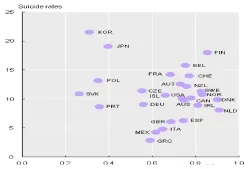
Figure 5: Suicide rates (2006 or latest available year) and life satisfaction (2008 or latest available year); Source: OECD, 2010
Suicide and subjective well being: domestic context
In this section I will examine the trends in Japanese suicide and subjective well being in light of the development of Gini-coefficient and GDP/capita within domestic context (Figure 6-9).It can be observed that Japan has experienced a sharp increase in suicide from the mid 20th century paralleling the financial crisis in East Asia.As shown in Figure 6 and 7, Japanese suicide rates rose rapidly from 16.9 per 1,000,000 persons to 23.9 per 1,000,000 persons during the period of 1995 and 1998 but reduced from that point to 22.3 per 1,000,000 persons in 2000 while Gini-coefficient coincidently increased from 0.32 to 0.34 between 1995 and 2000.It seems that the increase in suicide rates is largely accounted for the unemployment and bankrupt during the financial crisis and negative social climate and prospect on economic downturn (decline of GDP/capita in Figure 9) rather than the exacerbated income inequality (Watanabe et al, 2006).In spite of traditional motive of suicide – health problem (Figure 8), the economic and livelihood became major motivation of suicide which has seen a skyrocket from 3556 cases to 6068 cases merely between 1997 and 1998.Employment and career problem also increased slightly from 1800 cases to 2100 cases between 1997 and 1998.After recession, Japan began a long period of stable economic (GDP/capita) growth from 1998/9.Gini-coefficient continued to decline until 2003 and back to a lower line than that of 1995 as suicide rates were going down from 23.9 to 21.4 per 100,000 persons between 1999 and 2001.In this period, suicide rates looks like correlating with income inequality.However, this was not true for the later tendency where suicide rates did not follow the upward trend in GIni-coefficient rather it was fluctuating and gradually stabilising at the line of 21 per 1,000,000 persons.Commitment to suicide motivated by economic and livelihood problem reached its second peak at 2003 also largely is affected by bankrupt and accompanying negative social sensation when unemployment rates at this year peaked above 5% (Watanabe et al, 2006).
The subjective well being data came from the study conducted by Commission on measuring well-being (Uchida et al, 2011), initiative by Cabinet Office, Government of Japan.The study also distinguished the concepts between happiness and life satisfaction that is happiness refers to “a state of contented pleasantness which is categorized as an emotion in response to events that occur on a daily basis”, while life satisfaction is used to “capture how well people are doing in all aspects of their life, or in other words, how happy they are in the overall evaluation of their life” (Uchida, 2011: p1).The study address that Japan is in effect suffers from the “paradox of happiness”, particularly after the Japanese post-war economic miracle, and it is reported that Japanese are less happy with their life in comparison to other developed countries.For instance, a significant number of people are believed to suffer from an excessive amount of stress and depression, and they find it difficult to have hope for their future (Uchida et al, 2011: p2).Suicide is the most common cause of death among males in their 20s to early 40s, and among females in their late teens to early 30s.Furthermore, the elderly are reported to suffer most from unhappiness in Japan despite the international trend that the aged population has a higher level of happiness (Cabinet Office, 2009).In Figure 9, at the beginning of the 1990s, it is a period of growth but associated with no improvement on happiness and reversed tendency of life satisfaction.Even when GDP/capita started to keep growing after the financial crisis in East Asia in1998, life satisfaction did not stop getting worst until 2005.In this period, income inequality experienced Paradoxically, life satisfaction attempted to back to 1990’s level before the recent recession in 2008, regardless of the growing income inequality in this period.The experience of happiness on daily basis slightly decreased between 2010 and 2011 from the lineof 1990 rather than follow the recent serious recession and rapidly rising inequality but it still remained relative low level as the GPD/capita in this period was much higher than in 1990.

Figure 6: Trend in? income inequality measured by Gini-coefficient, Japan 1995-2009;
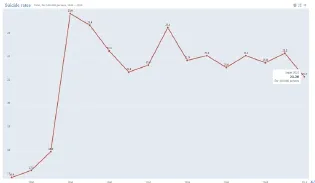
Figure 7: Trend in suicide rates, Japan 1995-2010;

Figure 8: Trends in motives of suicide (in Japanese);
Note: the motives of suicide at the bottom from left to right are family problem, health problem, economic and livelihood problem, Employment and career problem, love affair, school issue, other and the unknown.
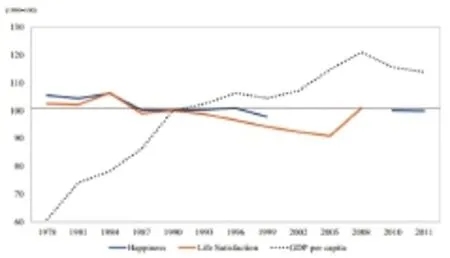
Figure 9: Trends of well-being in Japan;
Note 1: the data of “happiness” and “life satisfaction” are extracted from the National Survey of
Lifestyle Preference (NSLP) from fiscal year 1978 to 2011.(1990=100) Note 2: GDP per capita is calculated by using the System of National Accounts, and the GDP
Quarterly Report, and the Population Forecast.(1990=100)
Explaining Japanese high suicide rates and low subjective well being: social status or social capital?
From the international comparison and domestic data, it may be concluded that, firstly, on a global scale, Japan is less successful in respects of suicide and subjective well-being even it has more egalitarian income distribution; secondly, the development of income inequality in not consistent with trends in suicide rates and subjective well being in domestic context; thirdly, the previous indicates no irrelevance between income inequality and suicide and subjective well being rather income inequality makes mediated and subtle impact on both issues via some kind of mechanism (for example psychosocial pathway of hierarchy) as suicide rates retains high level and subjective well-being retains low level.On that basis how can we explain high suicide rates and low subjective well being or other social and health outcome in Japanese society?
Argued by Wilkinson and Pickett, the possible mediation of income inequality tends to be psychosocial pathway of social stratification and hierarchy that is the degree of income inequality in advanced nations is closely linked to the degree of status and in turn to their citizens’experience of status anxiety, and in many cases, of harming social cohesion and overall well being (Goldthorpe, 2010: p737).However, Goldthorpe (2010: p738) suggests that this claim is questionable.At the first place, Wilkinson and Pickett did not well conceptualise what social stratification is rather they conflated the social status with income inequality as inadequate and one-dimensional understanding of social inequality because of the need of appropriate international comparable data (Goldthorpe, 2010).Secondly, the outlier of Japan features the marked status hierarchical order even it seems to be the most equal society in the world in terms of income distribution (Goldthorpe, 2010).In order words, not all status differences are mapped by income inequality at individual level as well as at the societal level.The relationship between them that exists in very society can be highly variable.In the case of Japan, hierarchy is to an unusual degree formulised and embodied in extensive day-to-day usage of honorific, “wrapping”dressing and even decorating (Hendry, 1987 and 1993, Kerbo, 2003 and Nakane, 1970).The status difference is established on routine basis, which derives from both inter-personal and inter-grouping relationship with relative reference to a range of status marker such as age, sex, occupation, length of career, place of employment etc (Hendry, 1987 and 1993 and Kerbo, 2003).A clear status hierarchy is very complex and highly dependent on situational relativism, subjective perception and expectation so it is quite usual that those successful persons in Japanese society are those who can perceive and present their relative position in most occasional and contextual social relation modestly or appropriately (Hendry, 1993: pp101-125).All daily social interaction can be possessed in an orderly manner only once this ranking is clearly established (Kerbo, 2003: pp479-80).Therefore it is impossible to operationalise a well classified layered hierarchy for Japanese society because it needs to aggregate each particular social encounter or setting and a set of relevant status markers into an orderly pyramid (Nakene, 1970).In addition, taking the status difference for granted and regarding high status as compensation for low income indicate a critical fact that the “account of the psychosocial processes through which the benign contextual effects of relatively low-income inequality are mediated, involving a low level of status concerns, does not then appear to fit well with the Japanese case” (Goldthorpe, 2010: p738).
There is an alternative provided by Marmot (2004) who takes the concept of “social capital” into account in his epidemiological research on Japanese population health.Marmot (2004) suggests that even Japan has been individualised or westernised in the post-war era, the starting point to examine its social well being is to see how Japan remains different.This is grounded on its cohesion nature of society which is protecting the Japanese against stress and disease(Marmot, 2004: p172).It has been argue that a cultural tradition in Japan of strong ‘grouporientation’, promotes social cohesion and ‘cultural equality’, supporting psychological well being and good health among Japanese people (Horiuchi, 2011).This Japanese culture is influenced by Asia value which can trace back to the teachings of Confucius: loyalty, respect and commitment to the collectivity (Marmot, 2004: p173).Unlike western countries community, formal social relationships from the micro (neighbourhood) to the macro (business) mainly base on trust, social connection, responsibility, loyalty and tradition.For example, Loss of trust is usually the cause of delink between different enterprises and companies rather than contractual issue.A high degree or responsibility of the group, characteristic more of is an important determinant of health and well-being of Japanese people.(Marmot, 2004: p170).
In turn, social capital can be generally defined as “a collective asset engendering social networks formed and maintained on the basis of shared norms of trust and mutuality” (Bridgen, 2006: p29).It is developed by Putnam (2000) who regards this concept as having significant public effect by the stock of social trust and reciprocity generated by active social network and civic engagement.His main interest lays in the existence of social relationship and the level of associational membership rather than the purpose of such public engagement and the distribution of power within these social relationships, particularly as it affects the ability of the least powerful to access social resources (Bridgen.2006: p30).On that basis, he claimed that “networks and the associated norms of reciprocity are generally good for those inside the network” (Putnam, 2000: p21).Nevertheless, this is not accepted by Bourdieu (1986) who also contributes to conceptualisation work of social capital.While the most explicit use of Putnam’s terminology of individual capital puts much emphasis on the direct link between social relation and social well-being, Bourdieu focus his attention on indirect side of this concept that is how social relationship and network reflect and reinforce social stratification (Bridgen, 2006: p32).In contrast to Putnam who comments social capital as public good, Bourdieu is centrally concerned with individual effect of social network on the ability to access to resources and secure them (Bridgen, 2006: p32).He considers that the volume of social capital that can be possessed by a given agent is dependent the size or richness of the network and the other relevant capital that he is able to connect and possess in his own right (Bourdieu, 1986).For example, “while disadvantaged groups may have strong social networks within their own social class group (bonding social capital), they tend not to have strong or extensive connections with more advantaged groups (bridging social capital) whose stocks of collectively owned capital are richer”(Bridgen, 2006: p33).Access to advantaged bridging capital may be restricted by those members who want to retain their advantage or superiority in the group if no clear conditions norms have been established (Bridgen, 2006: p33).Furthermore, commentators like Foley and Edwards (1999) have sought to advance this concept to more explicit and comprehensive connection involving both authors’ views.As Bridgen (2006) suggests the significance of this concept still remains a contested issue and definition of social capital varies from one research theme to another.But it offers a highly potential way of thinking about the community and social network that we have taken for granted may be associated with our overall well being.
Putnam’s work has featured strongly in the income distribution and health field because it provided a potential way to examine the mediated effect exerted by income inequality (Bridgen, 2006: p31).Kawachi et al (1997), for example, argued that States with lower income inequality in America tend to feature as higher associational membership and trust and lower mortality rate and self-reported illness.High mortality rate seems to result in income inequality through disinvestment in social capital.Also a Japanese community-based study conducted by Ichida et al (2009) found that there is a significant association between income inequality (measured by Gini-coefficient) and individual-level trust.The study also confirms that there is a significant association between high community-level social capital (participation and associational membership) and good health, independent of individual-level social capital.Moreover another spatial research in Tokyo conducted by Okamoto et al (2013: p310) directly concluded that rather than structural social capital (e.g.participation in organisation), “social trust (cognitive social capital) was the most associated with suicide”and “social trust is expected to play a central role in developing emotional support and mutual respect in the community”.The Japanese wellbeing study (Figure 10) also finds that 10% of the population is feeling lonely at school, in the community, at work and even at home and the loneliness leads to lower happiness.Figure 11 extends this idea further that lower degree of happiness leads to higher suicidal ideation.Figure 12 proves that there is a positive correlation between people who have a high level of well-being and those who participate in social activities.Tokuda and Inouchi (2008) concluded that the interpersonal mistrust is significantly associated with happiness among Japanese people independent of occupation, gender and religion.Hence it can be summed up from these analyses that social capital and social cohesion pathway is a more appropriate way to explain Japanese social and health outcome.
This pathway may be able to explain why Japan is less successful in terms of suicide and subjective on a global scale.When define (or reduce) social capital as trust, social network support and civic engagement (more closed to Putnam’s concept), with reference to Better Life Index (OECD, 2013), Figure 13 – 14 illustrates the perceived social network support and voter turnout in OECD countries.It is obvious that Japan has relative lower percentage of people who have relatives or friends (90%) can count on which ranks 21st in 36 countries, slightly higher than OECD average (89%) and percentage of votes cast among the population registered to vote (59%) is extremely low compared to other countries (33rd in 36) which shows a strong disenchantment to politics.Besides, OECD (2013) also reported that people in Japan spend 4 minutes per day in volunteering activities, in line with the OECD average and around 25% reported having helped a stranger in the last month, the lowest rate in the OECD where the average is 49%, which reflects very weak trust and less confidence in others among Japanese people.Also only 17% of people say they trust their national government, much less than the OECD average of 39% (OECD 2013).Therefore the reason why Japan is less successful in terms of suicide and subjective well being may be partly that Japanese people has lower social trust, lower social network support and lowercivic engagement.

Figure 10: The percentage of people who feel lonely in various places;

Figure 11: The relationship between suicidal ideation and level of happiness;
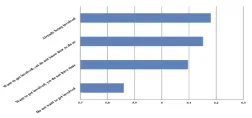
Figure 12: Motivation towards engagement with social activities and level of well-being;

Figure 13: Perceived social network support, percentage of people who have relatives or friends can count on, 2012; Source: OECD, 2013
Conclusion

Figure 14: Voter turnout, percentage of votes cast among the population registered to vote;
In summary, firstly Japan is less successful in aspects of suicide and subjective well being than other developed countries e.g.UK and USA even it has more egalitarian income distribution, This is a an inverse outcome to conclusion of The Spirit Level.However, one can argue that it is opportunistic to pick up suicide and subjective well being without deliberately theorising social well being and relevant social and health outcome, the same as what Wilkinson and Pickett have done in their book (Saunders, 2010).This is a key limitation of this case study because it is true some social problems are more prominent in more equal society for example suicide that I have picked up.More comprehensive investigations are needed to examine the correlation or causality between income inequality and a wide range of social problems on both domestic basis and international basis.
Secondly, the relation between the development of income inequality, suicide and subjective well-being is discrete.Increase in income inequality does not coincidently link to the increase in suicide and decline in subjective well being.This result dose not entail there is no relevance among.Rather income inequality may have mediated impact on social well being through the mechanism of social capital as I have suggested.However, this assumption may not proved clearly enough due to data availability.More detailed and regressive analyses may be needed.
Thirdly, psychosocial pathway of social stratification and hierarchy is not an appropriate way of understanding Japanese social well being in relation to income inequality while social capital or social cohesion pathway is more appropriate and expectable.Although the concept of social capital itself is still in its infant stage and its significance still remains contested, the construct offers a way of thinking about potentially important but difficult-toquantify aspects of community and trust that may be associated with social well-being.It is still possible and well worthy to apply other conceptualisation in further research e.g.Bourdieu’s conceptualisation or even synthesize the both.I thus call this approach as social capital and social cohesion pathway even if Putnam’s conceptualisation relates to psychosocial pathway.In addition, there are many issues remain unclear and vague.The last examination of Japanese social capital associated with suicide and subjective well being seems to be contradictory to the assumption of cohesive nature of Japanese society.If social cohesion is central to Japanese society, is it more cohesive than other countries by merely measuring social capital? What is the best way to measuring social capital or cohesion in Japan (do we need to include vote rates and trust in government)? If social capital is significant but relative low in Japan, why other social and health outcome of Japan remains top class on a global scale e.g.life expectancy? Or put, to what extent social capital make influence on them? Is there really a casual relation between them? Further investigations about these issues ought to be carried out in future.些年随着政策的变化与经济发展的原因,高等职业院校得到了飞速的发展,但是在教育教学中,老师才是真正的主导者,在进行高等职业教育教学改革时,教师是关键,教学成果是用来衡量改革是否成功的标准。在高等职业院校中,教师基本上都是各个高校的毕业生,他们虽然有着扎实的理论基础根底,但是他们缺乏实践能力,他们对于专业技能的认识程度与他们对技能的掌控程度不相符,在进行教学时他们无法及时指出学生在实际操作中所犯的错误。而且在日常的技能教学中,专业技能老师对于实践操作的认识高,但对于理论知识理解较差;理论课教师对于理论的认识高,但是动手实践能力差,这样的教学不利于学生将理论与实践结合起来综合的学习。所以要完成高等职业教育教学的改革,加强院方的师资力量是势在必行的,我们必须培养一支师德高尚、教育观念新、创新意识强、专业理论扎实、技能水平过硬的双师型教师队伍。
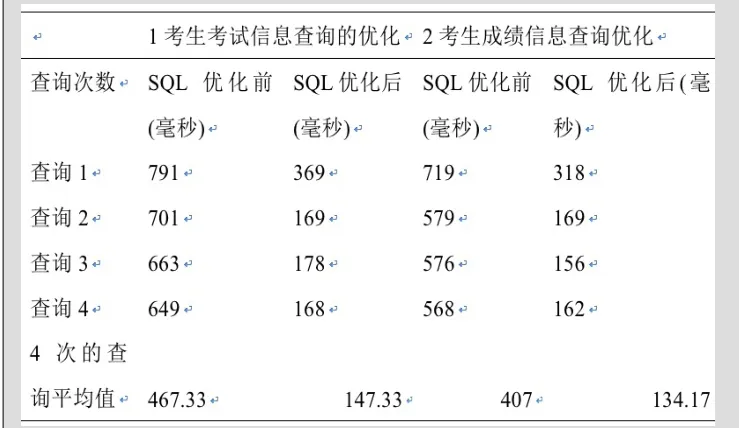
?
语句测试结果生成的直方图如图3-1所示:

图3 -1 Oracle SQL优化前后的性能对比
从图3-1中我们能够看出,学生考试系统的考试信息查询SQL语句优化理论对以上SQL语句进行了优化调整,SQL语句的査询速度得到了很大的提升。考生考试信息查询的速度平均提高了68.47%,考生成绩信息查询的速度平均提高了67.03%,从图中我们可以看出优化以后的查询速率确实有了明显的改善,且优化效果很好。
英国南安普顿大学)

